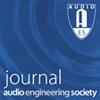Audio Capture Using Structural Sensors on Vibrating Panel Surfaces
IF 1.6
4区 工程技术
Q3 ACOUSTICS
引用次数: 3
Abstract
The microphones and loudspeakers of modern compact electronic devices such as smartphones and tablets typically require case penetrations that leave the device vulnerable to environmental damage. To address this, the authors propose a surface-based audio interface that employs force actuators for reproduction and structural vibration sensors to record the vibrations of the display panel induced by incident acoustic waves. This paper reports experimental results showing that recorded speech signals are of sufficient quality to enable high-reliability automatic speech recognition despite degradation by the panel’s resonant properties. The authors report the results of experiments in which acoustic waves containing speech were directed to several panels, and the subsequent vibrations of the panels’ surfaces were recorded using structural sensors. The recording quality was characterized by measuring the speech transmission index, and the recordings were transcribed to text using an automatic speech recognition system from which the resulting word error rate was determined. Experiments showed that the word error rate (10%–13%) achieved for the audio signals recorded by the method described in this paper was comparable to that for audio captured by a high-quality studio microphone (10%). The authors also demonstrated a crosstalk cancellation method that enables the system to simultaneously record and play audio signals.在振动面板表面使用结构传感器进行音频捕获
智能手机和平板电脑等现代紧凑型电子设备的麦克风和扬声器通常需要穿透外壳,这会使设备容易受到环境破坏。为了解决这一问题,作者提出了一种基于表面的音频接口,该接口使用用于再现的力致动器和结构振动传感器来记录由入射声波引起的显示面板的振动。本文报道了实验结果,表明记录的语音信号具有足够的质量,能够实现高可靠性的自动语音识别,尽管面板的谐振特性会降低。作者报告了将包含语音的声波引导到几个面板的实验结果,并使用结构传感器记录面板表面随后的振动。通过测量语音传输指数来表征记录质量,并使用自动语音识别系统将记录转录为文本,由此确定产生的单词错误率。实验表明,用本文所述方法记录的音频信号的单词错误率(10%-13%)与用高质量录音室麦克风捕获的音频的错误率(10%)相当。作者还演示了一种串扰消除方法,使系统能够同时录制和播放音频信号。
本文章由计算机程序翻译,如有差异,请以英文原文为准。
求助全文
约1分钟内获得全文
求助全文
来源期刊

Journal of the Audio Engineering Society
工程技术-工程:综合
CiteScore
3.50
自引率
14.30%
发文量
53
审稿时长
1 months
期刊介绍:
The Journal of the Audio Engineering Society — the official publication of the AES — is the only peer-reviewed journal devoted exclusively to audio technology. Published 10 times each year, it is available to all AES members and subscribers.
The Journal contains state-of-the-art technical papers and engineering reports; feature articles covering timely topics; pre and post reports of AES conventions and other society activities; news from AES sections around the world; Standards and Education Committee work; membership news, patents, new products, and newsworthy developments in the field of audio.
 求助内容:
求助内容: 应助结果提醒方式:
应助结果提醒方式:


